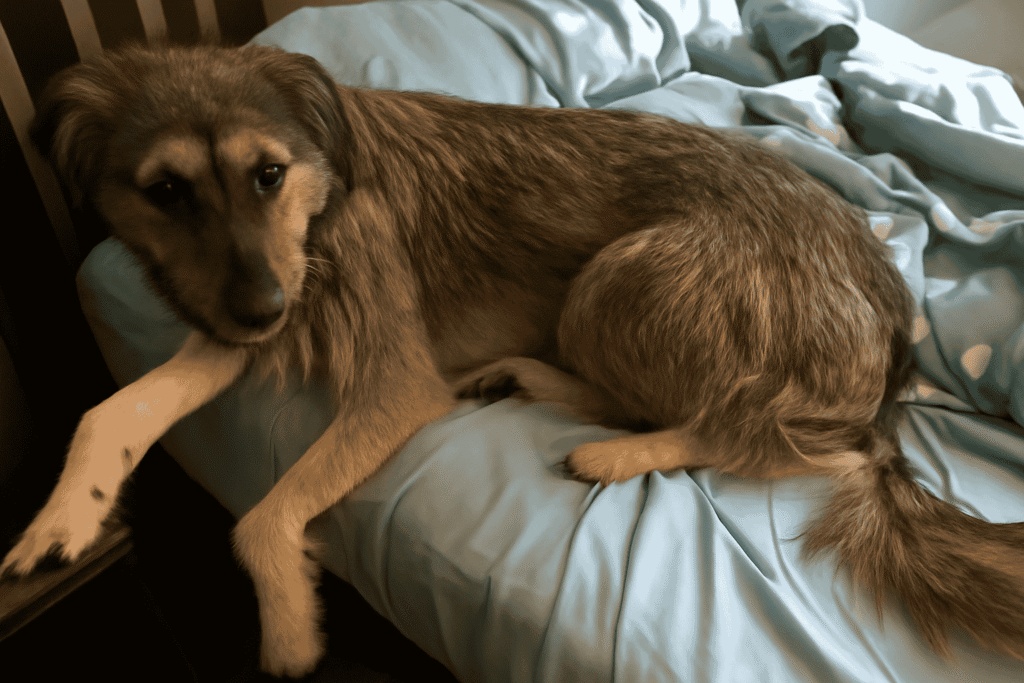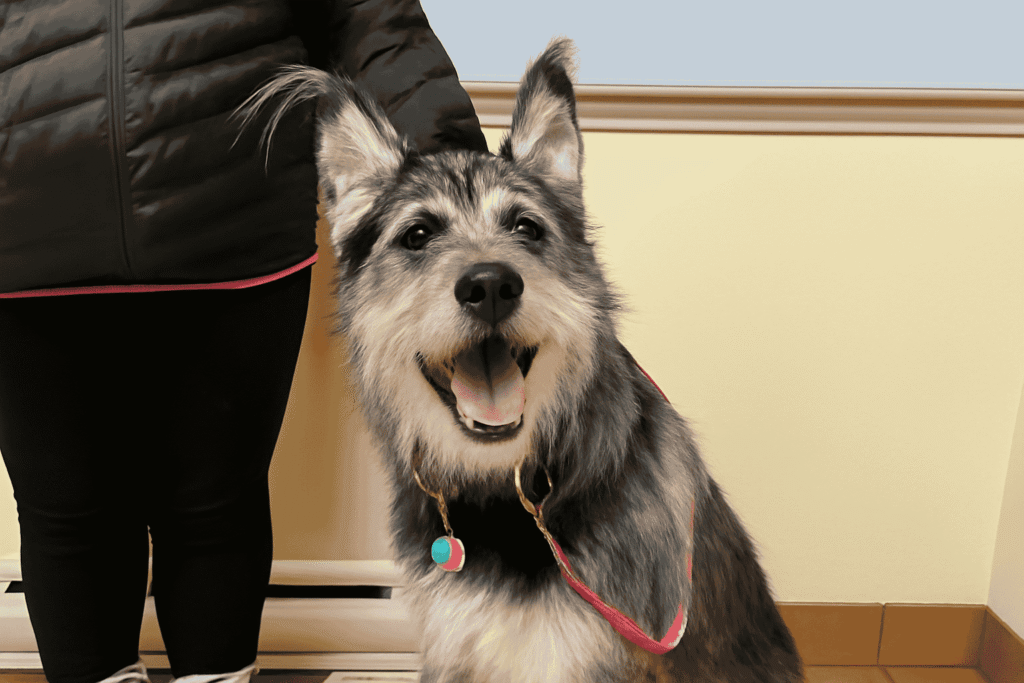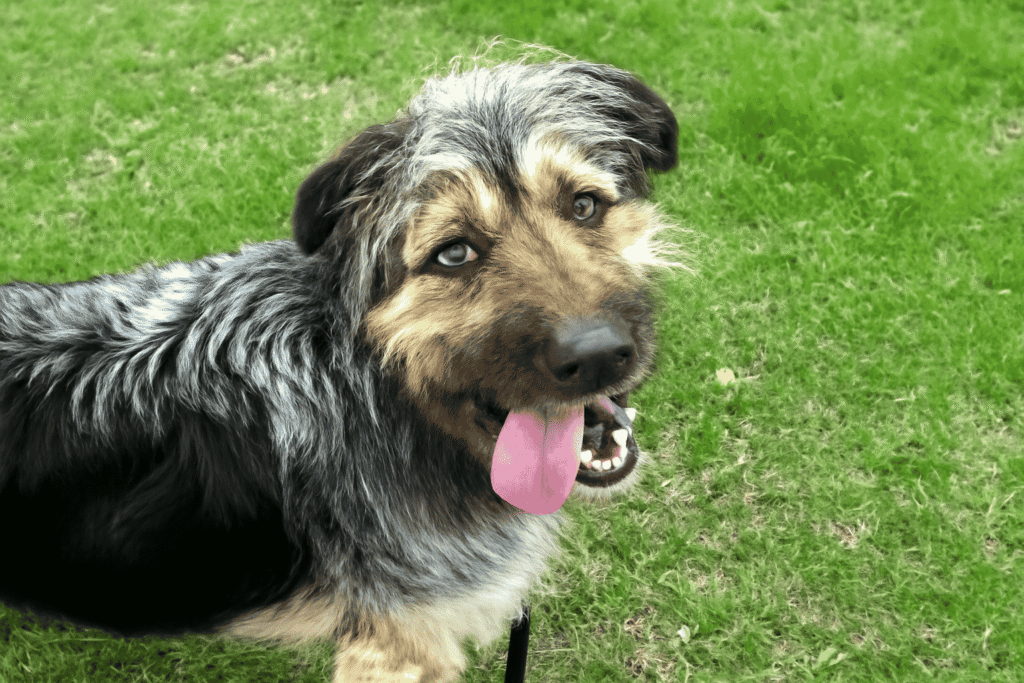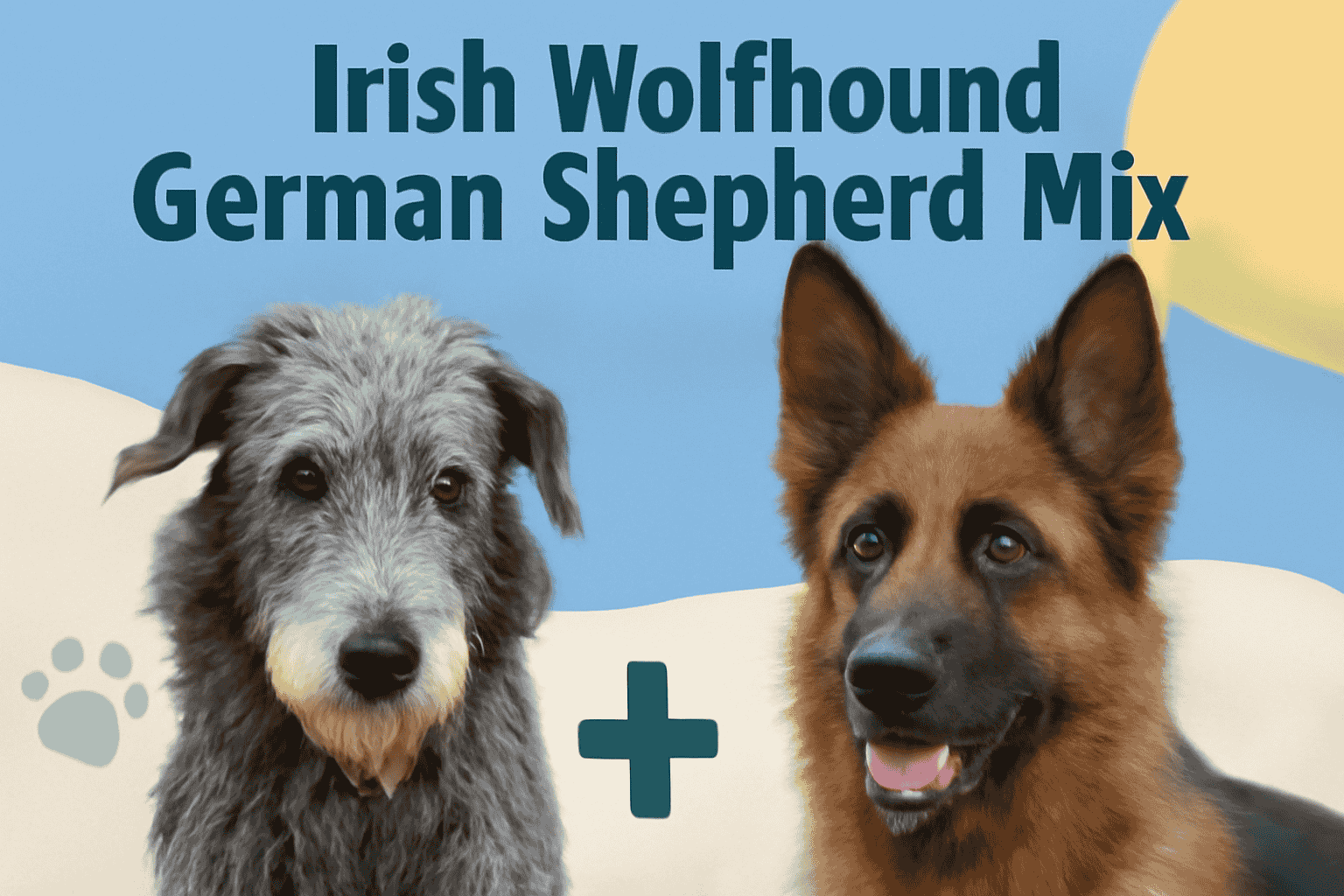The Irish Wolfhound German Shepherd mix stands and weighs between 70 to 120 pounds. This impressive hybrid turns heads everywhere it goes. We found that this magnificent mixed breed isn’t just striking in appearance—it’s also one of the harder-to-find designer breeds, mainly because Irish Wolfhounds are much rarer than German Shepherds, 25 to 32 inches tall
The sort of thing I love about the wolfhound German shepherd mix is how these gentle giants impact our lives, though they stay with us for a shorter time than other breeds. They inherit the Irish Wolfhound’s brief lifespan instead of the German Shepherd’s 10-14 years. These pups come with a hefty price tag, ranging from $1,000 to $4,000. Their massive size might seem intimidating, but they get along great with kids. Their strong prey drive can make them challenging around smaller pets, though. On top of that, these dogs need plenty of exercise—at least 2 hours daily. They might inherit health problems like hip dysplasia and heart conditions from both parent breeds. Let me share everything about this unique crossbreed that most owners learn only after bringing their Irish Wolfhound German Shepherd mix puppies home 6-8 year lifespan
The Basics You Should Know About the Irish Wolfhound German Shepherd Mix
Looking at the Irish Wolfhound German Shepherd mix up close reveals an amazing blend of two unique breeds. This hybrid brings together the Irish Wolfhound’s regal stature and the German Shepherd’s confident bearing to create an impressive and lovable companion.
Size, weight, and appearance overview
The Irish Wolfhound German Shepherd mix shows a lot of variety in how they look, which you’d expect from hybrid breeds. Males usually stand between, and some grow even bigger. Females are a bit smaller but still keep the impressive size that makes this crossbreed special.25-32 inches tall and weigh anywhere from 70-120 pounds
These dogs have a double coat with a soft undercoat under a medium-length outer layer that ranges from straight to wiry. Their coat colors can be anything you see in both parent breeds – from the classic black and tan German Shepherd pattern to the gray, fawn, or brindle colors of the Irish Wolfhound.
Each puppy in a litter might look different, unlike purebred dogs. Some get the straighter, denser coat of the German Shepherd, while others end up with the Irish Wolfhound’s shaggy look. Their body tends to be longer than wide with a slight back slope. They sport a bushy, long tail and a long muzzle with a black nose.
Common personality traits
These dogs blend the best qualities from both parent breeds. They’re incredibly loyal and love their families. Their protective nature makes them great watchdogs, but they’re not aggressive by nature.
The sort of thing I love about these family companions is their patience with kids of all ages. Both parent breeds pass down this gentle nature, so these dogs stay calm even during rough play. The smarts they get from both sides—especially the German Shepherd—make training easier.
Their social habits include:
- A balanced approach to strangers that mixes protection with friendliness
- Playfulness that matches their family’s energy
- The need to meet other animals early because to their hunting instincts
These dogs adapt well to different living situations if they get enough exercise and mental challenges.
Why are they so rare
The Irish Wolfhound German Shepherd mix remains uncommon despite its great qualities. The biggest problem comes from how rare Irish Wolfhounds are. German Shepherds have stayed popular worldwide for over 100 years, but Irish Wolfhounds are nowhere near as common [link_2]—mostly because they’re so big.
It’s really hard to find breeders who focus on this specific mix. Most of these crosses happen by accident rather than through planned breeding. So people who want this unique combination usually check animal shelters or classified ads instead of established breeders.
There’s another reason these dogs aren’t more popular: they often inherit the shorter lifespan common to giant breeds. Some families hesitate to adopt a dog that might only live 6-8 years.
Hidden Health Challenges Most Owners Overlook

The irish wolfhound german shepherd mix has more to worry about than just their impressive size and loyal nature. Many new owners don’t realize the health challenges these gentle giants face until they bring one home. These dogs need special medical attention that deserves a closer look.
Joint and bone issues beyond hip dysplasia
Hip dysplasia gets a lot of attention in large breeds, but the Irish wolfhound german shepherd mix faces other joint problems that often go unnoticed. Many Irish Wolfhounds develop elbow dysplasia, specifically. This happens when a part of the ulna bone doesn’t fuse properly during growth. The result is arthritis in the elbow joint that causes pain throughout the dog’s life. united anconeal process (UAP)
These dogs can also develop several bone disorders as they grow quickly. Panosteitis creates painful inflammation in leg bones’ outer layers and makes puppies limp from one leg to another. The Irish Wolfhound genetics bring an even bigger worry – bone cancer (osteosarcoma). This aggressive cancer has a 0.65 heritability rate in Irish Wolfhounds and usually strikes dogs under five years old.
The sheer size of this mix puts huge pressure on joints over time, so arthritis can develop even without hip dysplasia. Their quick growth as puppies makes them easy to injure during development.
Heart conditions specific to this mix
Heart disease stands out as the biggest hidden health risk in the wolfhound german shepherd mix. The Irish Wolfhound parent passes down a high risk of heart problems about. This heart rhythm problem happens when the heart’s upper and lower chambers beat out of sync, making the heart less effective 12% of purebred Irish Wolfhounds develop atrial fibrillation
Dogs with atrial fibrillation usually develop dilated cardiomyopathy (DCM) later. DCM makes the heart muscle stretch while its walls get thinner. The heart grows larger but works less effectively. This condition kills more Irish Wolfhounds than anything else.
German Shepherds add their heart problems to the mix, which could make things worse. Watch for signs like low energy, weight loss despite normal eating, pale gums, dry coughing, and breathing more than 40 times per minute at rest.
Why early health screening matters
Irish wolfhound german shepherd mix puppies need early health screening because they hide their symptoms well. These dogs rarely show signs of illness until things get serious. The Irish Wolfhound Club of America points out that “Wolfhounds are often slow to complain about pain or sickness, being a strong and stoic breed”.
Recommended health screenings include:
- Annual cardiac exams with EKG starting at 2-3 years old
- Hip and elbow dysplasia checks after age two
- Congenital eye disease screening
- Regular bone cancer checks
- Liver shunt testing for puppies before adoption
Board-certified veterinary cardiologists should handle heart screenings instead of regular vets. Finding heart issues early leads to better treatment results and happier dogs. Many irish wolfhound mix with german shepherd dogs live longer, better lives thanks to medications like Vetmedin.
Treatment options become limited if you wait for symptoms to show up. Early detection and proper care can control many life-threatening conditions. This gives your German Shepherd wolfhound the best shot at a comfortable life.
Behavioral Surprises You Might Not Expect

Most people who want to own an Irish wolfhound german shepherd mix make assumptions based on their parent breeds’ reputation. These unique hybrids can surprise even seasoned dog owners with unexpected traits. Let’s explore some surprising behavioral characteristics that could shape your decision about this remarkable crossbreed.
Not always a natural guard dog
This imposing mix isn’t the fierce protector you might expect. German Shepherds excel at guarding, but Irish Wolfhounds are “too serene to be fierce guard dogs”. These gentle giants rarely show the aggressive protective instincts most people expect.
All the same, they still offer security benefits. One owner points out that “just the sight of them is enough to deter intruders”. Their impressive size naturally deters threats, even though they’re typically friendly and gentle. These dogs may look intimidating, but usually take after the Irish Wolfhound’s “gentle giant persona” instead of being aggressive guardians.
Prey drive and chasing instincts
The most surprising challenge owners face is their wolfhound german shepherd mix’s intense prey drive. Both parent breeds “can have strong prey drives”. This creates powerful hunting instincts that need careful handling.
The Irish Wolfhound genes amplify this trait since they “retain a strong instinct to hunt and chase prey”. This means owners should:
- Keep them in securely fenced areas off-leash
- Use a leash during walks
- Avoid homes with cats or small pets
Small animals face real risks with this mix because “there is no scenario where that ends well” if a 100-pound dog chases a cat through your house.
Emotional sensitivity and anxiety
The Irish wolfhound german shepherd mix’s emotional sensitivity catches many owners off guard. Irish Wolfhounds have an “innate sensitivity to human emotions” and can detect their owner’s anxiety, sadness, or stress. This emotional awareness makes them incredibly responsive to your moods.
These dogs can experience anxiety, too. About 14 percent of dogs deal with separation anxiety, and the Irish wolfhound mix with german shepherd might be more susceptible due to their family bonds. Watch for destructive behavior, excessive barking, or house accidents during alone time.
Their sensitivity makes them “excellent candidates for therapy work”. They naturally connect with human emotions. This emotional intelligence combines with their gentle nature to create a dog that reads your needs instinctively.
Living With a Giant: Home and Lifestyle Adjustments
Welcoming an irish wolfhound german shepherd mix to your family demands lifestyle changes that go way beyond the reach and influence of typical large breed ownership. My extensive research about these majestic giants shows that the right living conditions make a real difference in their wellbeing.
Space requirements inside the home
The wolfhound german shepherd mix needs a home with plenty of open space to move around. These dogs do best in houses without stairs because climbing steps can put extra stress on their developing joints. A standard apartment just isn’t enough room for them to thrive.
Your outdoor space needs a secure fence around at least half an acre to give them proper exercise room. The fence height should be at least five feet – these athletic hybrids can jump over anything shorter if they see something worth chasing. Of course, invisible or electric fences won’t work since these dogs barely notice a mild shock if they spot potential prey.
Exercise needs that change with age
The Irish wolfhound german shepherd mix puppies need careful exercise management at the start. These puppies can hurt their developing joints through intense exercise, unlike smaller breeds. Short, regular walks and natural playtime work better than vigorous activities.
Adult usually need 30-45 minutes of moderate exercise daily, though some might need up to 2 hours spread throughout the day. Swimming is a great low-impact option that builds strength without stressing their joints.
Senior dogs still need exercise, but in ways that suit their aging bodies. Gentle, short walks and controlled swimming help keep their muscles strong without causing discomfort. Senior dogs often lose strength in their back legs, so targeted exercises are vital to help them stay mobile.
Feeding a large breed without causing harm
The Irish wolfhound german shepherd mix needs careful attention to these feeding aspects:
- Portion control – overfeeding puppies guides them toward orthopedic problems
- Limited calcium – in stark contrast to this common belief, extra calcium can harm developing joints
- Quality ingredients – high-protein foods made specifically for large breeds
Smaller meals throughout the day substantially lower the risk of bloat compared to one big meal – this condition can be fatal in deep-chested breeds. You should also avoid exercise for 1-2 hours after meals to protect against gastric torsion.
Finding and Raising Irish Wolfhound German Shepherd Mix Puppies

Getting your hands on an irish wolfhound german shepherd mix puppy can be trickier than other designer breeds. My research has shown that locating these gentle giants takes time, dedication, and thorough investigation.
Why reputable breeders are rare
The Irish Wolfhound German Shepherd mix lacks specialized breeders because Irish Wolfhounds themselves are quite rare. German Shepherds might be everywhere, but Irish Wolfhounds remain uncommon today. Most puppies of this mix result from accidental breeding instead of planned programs. Your search will likely lead to animal shelters or classified ads rather than breeders who specialize in this unique combination.
Adoption tips and what to ask shelters
The right questions can help you learn more about potential irish wolfhound german shepherd mix puppies at shelters. You should ask about the dog’s background and history, including their previous homes and emotional challenges. The shelter should provide all health records so you can check vaccination status and whether the dog has been fixed.
The dog’s personality match matters too. Ask how they behave around kids, new people, and other animals. These mixed breeds might have a strong prey drive, so their interaction with smaller pets needs careful consideration. Make sure the shelter accepts returns if things don’t work out – any good organization will offer this option.
Early socialization secrets for success
Your Irish wolfhound german shepherd mix puppy needs proper socialization from the start. A good temperament shows no signs of shyness or aggression. Start exposing your pup to new experiences daily once they reach 10-12 weeks. Let them explore different surfaces like grass, gravel, and carpet. They should get used to household sounds and meet various people.
These puppies get tired quickly, so keep activity sessions short but frequent. Regular car rides help them become good travelers. Positive meetings with other animals build their social confidence. A well-socialized puppy grows into a balanced, confident companion that brings joy to their family.
Conclusion
I’ve spent countless hours learning about the Irish Wolfhound German Shepherd mix and found this rare giant brings both amazing joys and big responsibilities. These magnificent hybrids need a level of commitment that’s nowhere near what other breeds require. Their short lifespan of 6-8 years and potential health issues like heart disease and joint problems mean you should think carefully before adopting one.
The good news is that owners who adjust their lifestyle will get an emotionally intelligent, gentle companion that bonds deeply with family members. This mix combines the Irish Wolfhound’s gentle nature with the German Shepherd’s intelligence to create a dog with amazing personality traits. You’ll need plenty of space, regular exercise, and careful diet management to raise them right.
It’s crucial to do your homework before bringing one of these rare dogs home. The best way to learn is by talking to current owners through social media groups or breed forums. They can tell you what daily life is really like with these gentle giants. A full veterinary care plan from puppyhood through senior years will help your dog live longer and better.
These dogs might have their challenges, but proper preparation makes everything easier. Their loyalty, emotional sensitivity, and impressive presence make it all worthwhile for dedicated owners. You won’t find many breeds that combine such magnificent size with gentle temperaments. While they might not be natural guard dogs, their size alone provides security value. Their loving nature brings joy to family life in countless ways.
FAQs
Q1. How big does an Irish Wolfhound German Shepherd mix typically get?
This mix can grow quite large, with males potentially reaching 25-32 inches tall and weighing between 70-120 pounds. Some individuals may even grow larger, depending on which parent breed they take after more.
Q2. What are the exercise requirements for an Irish Wolfhound German Shepherd mix?
As adults, these dogs generally need 30-45 minutes of moderate daily exercise, though some may require up to 2 hours spread throughout the day. It’s important to adjust exercise as they age, with gentler activities for seniors.
Q3. Are Irish Wolfhound German Shepherd mixes good family dogs?
Yes, they can make excellent family companions. They are typically gentle, patient with children, and form strong bonds with their families. However, early socialization is crucial to ensure they are well-mannered around strangers and other animals.
Q4. What health issues should owners be aware of with this mix?
These dogs can be prone to joint problems, heart conditions, and bone cancer. Regular health screenings are essential, including cardiac exams, hip and elbow evaluations, and checks for signs of bone cancer. Their lifespan is typically shorter than many other breeds, averaging 6-8 years.
Q5. How difficult is it to find an Irish Wolfhound German Shepherd mix puppy?
Finding this specific mix can be challenging. Most puppies result from accidental breeding rather than dedicated programs. Prospective owners often need to search animal shelters or classified ads rather than established breeders. It’s important to ask thorough questions about the puppy’s background and health when adopting.
